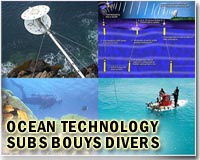| . |  |
. |
Rotterdam, Netherlands (AFP) March 21, 2011 Dubai's Palm Island, New Orleans' upgraded dykes and Australia's water recycling plants all have one thing in common: they benefited from Dutch know-how gained in the country's age-old quest for dry feet. "The Netherlands has always battled against this natural enemy -- water," said Hanneke Heeres of the Union of District Water Boards (UvW), which after 900 years existence is the Netherlands' oldest government body. "And with global warming and rising sea levels the world is more and more interested in Dutch expertise," he told AFP. Currently, Dutch companies are focusing efforts on projects on delta areas in five countries: Mozambique, Egypt, Indonesia, Bangladesh and Vietnam. An abiding image of the Netherlands is the boy from a famous children's tale who plugs a hole in a dyke with his finger to save his country from inundation -- and with reason: the country's lowest point is 6.74 metres (22.2 feet) below sea level. In all, 26 percent of the country is below sea level. "Already 10 centuries ago, the Dutch were making sand piles on which to build their homes, out of reach of the water," Bert Groothuizen of Van Oord dredging company told AFP. "As technology advanced, they designed machines like dredging boats," now being exported around the world along with Dutch water engineers. Today, the country has a global reputation in "delta-technology" - claiming some 40 percent of the world's turnover in the open market. This excludes states who protect domestic makers of flood-barriers, dykes and bridges with anti-competition measures. Out of a population of 16.5 million, the Netherlands also boasts some 2,000 companies in the field of water, employing about 80,000 people. "As early as the seventh century, Dutch specialists were creating canals and dikes near the Elbe" River in what is modern-day Germany, said Christine Boomsma, spokeswoman for Netherlands Water Partnership (NWP), an information network of companies, government, knowledge institutes and NGOs. Dutch savvy in the field has gone well beyond Europe and already been put to use in Africa, Asia and the Americas. Its experts helped build storm surge barriers in St. Petersburg and Venice, helped make Jakarta flood resilient and advised on climate adaptation plans for the Maldives and southeast Asia's Mekong Delta. "The United States became interested in our expertise after Hurricane Katrina" killed nearly 1,500 people in New Orleans in 2005, said Heeres of the UvW. "In New Orleans, we reinforced a line of dykes to make them more solid, higher, and bigger," added Matthijs van Ledden of the engineering firm Royal Haskoning. "We also constructed new flood barriers." Another example of Dutch ingenuity: artificial island complexes constructed in the sea off Dubai -- not only the ambitious Palm Island, in the shape of a palm tree, but another mimicking a map of the world. Dubbed simply The World, the second complex comprises more than 300 islands in the shape of the continents, fashioned out of more than 325 cubic metres (11,477 cubic feet) of sand dredged from the bottom of the ocean. This amount of sand "represents a wall of six metres high and two metres wide running right around the world," said Groothuizen of Van Oord, which helped create the islands. At home, some nine million Dutch live in areas directly shielded from the sea and rivers by dikes and dunes, which a government appointed commission warned in 2009 must be upgraded at a cost of 100 billion euros (140 billion dollars) over the next century. Floods in 1953 killed 1,835 people and left 72,000 homeless when a total 200,000 hectares (495,000 acres) of land in the southern provinces of Zeeland, Noord Brabant and Zuid-Holland were inundated. This jolted the traumatised nation into creating its so-called Delta Plan, a water management blueprint that led to a drastic shrinkage of the Dutch coastline through the construction of barriers and dykes. "Its advanced technology allows the Netherlands to help other countries with delta zones to be prepared" for natural disasters, according to Gaetano Casale of the UN cultural agency's (UNESCO) Institute for Water Education (IHE). "The world has its Silicon Valley, we want to be its Water Valley," said Boomsma, referring to the area in the US state of California synonymous with high-tech innovation. Tuesday marks World Water Day, an initiative that came out of the 1992 UN Conference on Environment and Development in Rio de Janeiro. The theme for 2011 is "Water for Cities: Responding to the Urban Challenge".
Share This Article With Planet Earth
Related Links Water News - Science, Technology and Politics
 Pacific islands push US to improve fisheries deal
Pacific islands push US to improve fisheries dealMajuro (AFP) March 19, 2011 A group of 17 Pacific island nations began putting pressure on the United States on Saturday to reshape a 23-year-old fisheries treaty. At the start of a consultation and renegotiation meeting in Majuro, the Marshall Islands Fisheries Minister Mattlan Zackhras said a "paradigm shift" has taken place in the tuna industry. Islands are demanding a greater share of fishing revenue, which wou ... read more |
|
| The content herein, unless otherwise known to be public domain, are Copyright 1995-2010 - SpaceDaily. AFP and UPI Wire Stories are copyright Agence France-Presse and United Press International. ESA Portal Reports are copyright European Space Agency. All NASA sourced material is public domain. Additional copyrights may apply in whole or part to other bona fide parties. Advertising does not imply endorsement,agreement or approval of any opinions, statements or information provided by SpaceDaily on any Web page published or hosted by SpaceDaily. Privacy Statement |